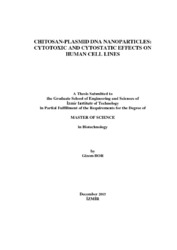Please use this identifier to cite or link to this item:
https://hdl.handle.net/11147/4571| Title: | Chitosan-Plasmid Dna Nanoparticles: Cytotoxic and Cytostatic Effects on Human Cell Lines | Other Titles: | Kitosan-plazmid Dna Nanoparçacıkları: İnsan Hücre Hatları Üzerine Sitotoksik ve Sitostatik Etkileri | Authors: | Bor, Gizem | Advisors: | Şanlı Mohamed, Gülşah Demir, Mustafa Muammer |
Keywords: | Chitosan Nanoparticles |
Publisher: | Izmir Institute of Technology | Source: | Bor, G. (2015). Chitosan-plasmid DNA nanoparticles: Cytotoxic and cytostatic effects on human cell lines. Unpublished master's thesis, İzmir Institute of Technology, İzmir, Turkey | Abstract: | Although chitosan nanoparticles (CNs) became a promising tool for several biological and medical applications owing to their inherent biocompatibility and biodegrability, studies regarding their effects on cytotoxicity and cytostatic properties still remain insufficient. Therefore, in the present study, we decided to perform comprehensive analysis of the interactions between CNs – pKindling-Red-Mito (pDNA) and different cell line models derived from blood system and human solid tissues cancers. The resulting CNs-pDNA was investigated with regard to their physical-chemical properties, cellular uptake and transfection efficiency, cytotoxic and cytostatic properties. The nanoparticles showed high encapsulation efficiency and physical stability even after 2 days for various formulations. Moreover, high gene expression levels were observed already 96 h after transfection. CNs-pDNA treatment, despite the absence of oxidative stress induction, caused cell cycle arrest in G0/G1 phase and as consequence led to premature senescence, which turned out to be both, p21-dependent and p21-independent. Also, observed DNMT2 upregulation may suggest the activation of different pathways protecting from the resulting CNs-mediated stress. In conclusion, treatment of different cell lines with CNs-pDNA showed that their biocompatibility was limited and effects were cell type-dependent. Kitosan nanoparçacıklar (CNs), kendi doğasında olan biyouyumluluk ve biyo-çözünürlülük özellikleri nedeniyle birçok biyolojik ve tıbbi uygulamalarda gelecek vaat eden bir araç olmasına rağmen, sitotoksisite ve sitostatik özellikleri üzerindeki etkileri ile ilgili çalışmalar yetersiz kalmaktadır. Bu sebeple, bu çalışmada, CNs – pKindling-Red-Mito (pDNA) ve farklı hücre hatları arasındaki etkileşimlerin kapsamlı bir analizini gerçekleştirmeye karar verdik. Elde edilen chitosan-plasmid DNA nanoparçacıkları; hücresel alınım, transfeksiyon verimi, fiziksel-kimyasal özellikleri, sitotoksik ve sitostatik etkileri bakımından incelenmiştir. Nanoparçacıklar, sentezlenen çeşitli formülasyonları için 2 gün sonrasında bile yüksek enkapsülasyon etkinliği ve fiziksel stabilite göstermiştir. Diğer taraftan, gen ekspresyonu, transfeksiyonun 96 saat sonrasında yüksek düzeyde gözlenmiştir. CNs-pDNA muamelesi, oksidatif stres indüksiyonunun yokluğu rağmen, G0 / G1 fazında hücre döngüsünün baskılanmasına sebep olmakta ve sonuç olarak, hem p21-bağımlı hem de p21-bağımsız olarak ortaya çıkan erken senesense neden olmuştur. Ayrıca, gözlemlenen DNMT2 upregülasyonu, oluşan CNs-kaynaklı stresi önleyici farklı yollarının aktivasyonu hakkında fikir verebilir. Sonuç olarak, CNs-pDNA ile muamele edilmiş farklı hücre hatları, parçacıkların sınırlı biyo-uyumluluğunun olduğunu ve etkilerinin hücre tipine-bağlı olduğunu göstermiştir. |
Description: | Thesis (Master)--Izmir Institute of Technology, Biotechnology, Izmir, 2015 Full text release delayed at author's request until 2018.01.25 Includes bibliographical references (leaves: 58-67) Text in English; Abstract: Turkish and English xii, 74 leaves |
URI: | http://hdl.handle.net/11147/4571 |
| Appears in Collections: | Master Degree / Yüksek Lisans Tezleri |
Files in This Item:
| File | Description | Size | Format | |
|---|---|---|---|---|
| T001434.pdf | MasterThesis | 3.73 MB | Adobe PDF |  View/Open |
CORE Recommender
Page view(s)
356
checked on May 12, 2025
Download(s)
108
checked on May 12, 2025
Google ScholarTM
Check
Items in GCRIS Repository are protected by copyright, with all rights reserved, unless otherwise indicated.